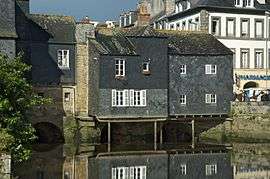Landerneau
| Landerneau Landerne | ||
|---|---|---|
|
Houses with a slate facade, on the Rohan Bridge | ||
| ||
 Landerneau | ||
|
Location within Brittany region  Landerneau | ||
| Coordinates: 48°27′06″N 4°14′53″W / 48.4517°N 4.2481°WCoordinates: 48°27′06″N 4°14′53″W / 48.4517°N 4.2481°W | ||
| Country | France | |
| Region | Brittany | |
| Department | Finistère | |
| Arrondissement | Brest | |
| Canton | Landerneau | |
| Intercommunality | Pays de Landerneau-Daoulas | |
| Government | ||
| • Mayor (2014–2020) | Patrick Leclerc | |
| Area1 | 13.19 km2 (5.09 sq mi) | |
| Population (2008)2 | 14,999 | |
| • Density | 1,100/km2 (2,900/sq mi) | |
| Time zone | CET (UTC+1) | |
| • Summer (DST) | CEST (UTC+2) | |
| INSEE/Postal code | 29103 / 29800 | |
| Elevation | 1–175 m (3.3–574.1 ft) | |
|
1 French Land Register data, which excludes lakes, ponds, glaciers > 1 km² (0.386 sq mi or 247 acres) and river estuaries. 2 Population without double counting: residents of multiple communes (e.g., students and military personnel) only counted once. | ||
Landerneau (Landerne in Breton) is a commune in the Finistère department of Brittany in north-western France.
It lies at the mouth of the Elorn River which divides the Breton provinces of Cornouaille and Léon, 20 km (12 mi) east of Brest. The name means "(religious) enclosure of St Ténénan (Welsh: Tyrnog)": allegedly a Welshman who also had llans in the Vale of Clwyd in North Wales and in Somerset, and who moved to Brittany in the 7th century. It was an important centre of the flax and linen industries in the 16th and 17th centuries. Today it is the main agricultural market in northwest Brittany.
A picturesque feature of the town centre is the sixteenth-century house-lined bridge (the Pont de Rohan) across the Elorn.
International relations
Landerneau is twinned with the towns of Caernarfon in Gwynedd in Wales and Hünfeld in Germany.
Music festival
Every year in August, a music festival called "Fête du bruit dans Landerneau" occurs in Landerneau. "Fête du bruit dans Landerneau" literally means "Noise (or Sound) fete in Landerneau" but when written "Faites du bruit dans Landerneau", it also means "Make some noise (or sound) in Landerneau" as it is a play on words based on the double meaning of the homophones "Fête" and "Faites".
Population
Inhabitants of Landerneau are called in French Landernéens. At the census of 1999, the town had a population of about 20, 000.
| Historical population | ||
|---|---|---|
| Year | Pop. | ±% |
| 1793 | 4,012 | — |
| 1800 | 3,669 | −8.5% |
| 1806 | 3,896 | +6.2% |
| 1821 | 4,317 | +10.8% |
| 1831 | 4,933 | +14.3% |
| 1836 | 4,963 | +0.6% |
| 1841 | 4,906 | −1.1% |
| 1846 | 4,934 | +0.6% |
| 1851 | 5,113 | +3.6% |
| 1856 | 6,518 | +27.5% |
| 1861 | 6,959 | +6.8% |
| 1866 | 7,853 | +12.8% |
| 1872 | 7,717 | −1.7% |
| 1876 | 8,195 | +6.2% |
| 1881 | 9,078 | +10.8% |
| 1886 | 8,927 | −1.7% |
| 1891 | 8,497 | −4.8% |
| 1896 | 8,038 | −5.4% |
| 1901 | 7,080 | −11.9% |
| 1906 | 7,737 | +9.3% |
| 1911 | 8,252 | +6.7% |
| 1921 | 7,735 | −6.3% |
| 1926 | 7,424 | −4.0% |
| 1931 | 8,004 | +7.8% |
| 1936 | 8,855 | +10.6% |
| 1946 | 10,975 | +23.9% |
| 1954 | 10,950 | −0.2% |
| 1962 | 11,834 | +8.1% |
| 1968 | 12,781 | +8.0% |
| 1975 | 14,541 | +13.8% |
| 1982 | 14,482 | −0.4% |
| 1990 | 14,269 | −1.5% |
| 1999 | 14,274 | +0.0% |
| 2008 | 14,999 | +5.1% |
Breton language
Landerneau has many bilingual signs (French and Breton), and is the first town where the indications in the local station were made bilingual, as a result of the Ya d'ar brezhoneg charter of the Ofis ar Brezhoneg.[1]
The municipality launched a linguistic plan through Ya d'ar brezhoneg on December 12, 2004. In 2008, 12.46% of primary-school children attended bilingual schools.[2]
Schools
There is a Diwan preschool and primary school in the town.
Transport
- The Landerneau Railway Station is situated on the Paris–Brest railway and the branch to Quimper.
- The RN 12; a trunk road connecting Landerneau to Brest and Paris.
See also
- Communes of the Finistère department
- Landerneau Parish close
- List of the works of Bastien and Henry Prigent
- List of the works of the Maître de Plougastel
References
- ↑ (French) Signalisation bilingue dans les gares : Landerneau, ouvre le bal (Bilingual signalisation in stations: Landerneau is the first one
- ↑ (French) Ofis ar Brezhoneg: Enseignement bilingue
External links
| Wikimedia Commons has media related to Landerneau. |
- (French) Official website
- (French) French Ministry of Culture list for Landerneau

.svg.png)
